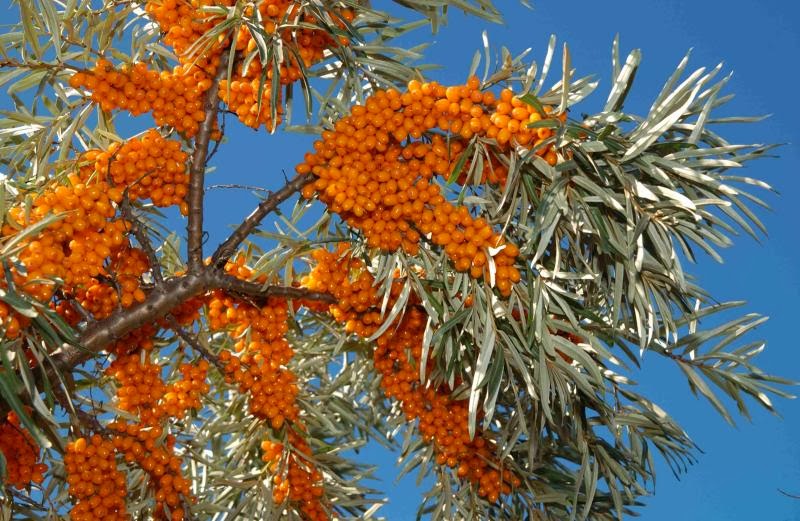Today, let's talk about another awesome shrub that we will be growing this year. This one is full of vitamins, anti-oxidants and minerals.
Sea Buckthorn shrub
Sea
Buckthorn, Hippophae rhamnoides - Sea buckthorn, or seaberry is a hardy (to zone 2!), thorny
shrub with edible fruit that also packs a punch. It has been used medicinally for at least 1200 years. These miracle bushes provide vitamins C, A, K, and E, beta-carotene, amino acids, organic acids, tannins, omegas 3, 6, 7, and 9, folic acid, 42 lipids, phenols, terpenes, copper, iron, gallic acid, magnesium, niacin, pantothenic acid, potassium, riboflavin, salicylic acid, sterols, boron, astralagin, glucosides, selenium, catechins, calcuim, ferulic acid, manganese, superoxide dismutase, carotenoids, lycopene, ellagic acid, quercetins, zeaxanthin, and fatty acids. All parts of the plant are full of nutrients.
Sea buckthorn is used to boost immunity, lower bad cholesterol, increase good cholesterol, help the heart and blood vessels, prevent diabetes, anti-inflammatory, protect against radiation, and help control weight. Your body will actually stop storing fat. By helping to control weight, it will prevent many of the aforementioned issues from developing. Sea buckthorn will help keep you regular and treat all sorts of GI issues, including upset stomach, GERD, ulcers, and heartburn. Can be used as an expectorant and is good for mucus membranes. Heals asthma and other lung issues. Protects the liver and used to treat arthritis. Sun burns, rashes, eczema, bed sores, wounds and other skin irritations are relieved by teas made from berries, flowers or leaves. It helps give you beautiful skin, hair and nails. Not only will you look and physically feel younger, your brain will function faster as well. Dr Oz boasted about the health benefits of sea buckthorn. It has been said to help prevent cancer and help reduce the side effects of harsh cancer treatments.
Just like the Elderberry, the raw berries are very tart. Cooking the berries changes them to a tropical citrusy flavor. If you prefer raw, you can mix the juice with sweet juices such as pear, carrot, or grape. You may also sweeten juice, syrups and teas with honey, stevia or agave.
Sea buckthorn berries are used to make oils, teas, extracts, syrups, juices, jellies and jams, salsa, cooking sauces, vinegars, vinaigrette, wine, candies, pies, sorbet, cookies, etc. They can also be dried or frozen to be used later.
The leaves are full of protein. Powerful teas can be made from the them. The leaves make very healthy fodder for animals. Be careful feeding them to horses though, as Pegasus was said to get his power of flight from sea buckthorn leaves!
Sea buckthorn is used to boost immunity, lower bad cholesterol, increase good cholesterol, help the heart and blood vessels, prevent diabetes, anti-inflammatory, protect against radiation, and help control weight. Your body will actually stop storing fat. By helping to control weight, it will prevent many of the aforementioned issues from developing. Sea buckthorn will help keep you regular and treat all sorts of GI issues, including upset stomach, GERD, ulcers, and heartburn. Can be used as an expectorant and is good for mucus membranes. Heals asthma and other lung issues. Protects the liver and used to treat arthritis. Sun burns, rashes, eczema, bed sores, wounds and other skin irritations are relieved by teas made from berries, flowers or leaves. It helps give you beautiful skin, hair and nails. Not only will you look and physically feel younger, your brain will function faster as well. Dr Oz boasted about the health benefits of sea buckthorn. It has been said to help prevent cancer and help reduce the side effects of harsh cancer treatments.
Just like the Elderberry, the raw berries are very tart. Cooking the berries changes them to a tropical citrusy flavor. If you prefer raw, you can mix the juice with sweet juices such as pear, carrot, or grape. You may also sweeten juice, syrups and teas with honey, stevia or agave.
Sea buckthorn berries are used to make oils, teas, extracts, syrups, juices, jellies and jams, salsa, cooking sauces, vinegars, vinaigrette, wine, candies, pies, sorbet, cookies, etc. They can also be dried or frozen to be used later.
The leaves are full of protein. Powerful teas can be made from the them. The leaves make very healthy fodder for animals. Be careful feeding them to horses though, as Pegasus was said to get his power of flight from sea buckthorn leaves!
Seaberry, part of the
Elaeagnaceae family, is a nitrogen fixer, which means that it pulls
nitrogen out of the air. Nitrogen is not readily available to most
plants. Seaberry sends the nitrogen down to it's roots where soil
microorganisms process it in exchange for sugars and nutrients, converting
it to a form of nitrogen that is available for uptake. This nitrogen is
also shared with nearby plants, especially as leaves, berries and twigs fall and begin to decompose.
Sea buckthorn grows 6 to 20 feet. Coppicing every few years will keep the berries at a reasonable height and replenish the soil with all that nutrient rich biomass. It grows well in most soil types and conditions. Known to grow near the coast (get it? "sea" berry), so it is even ok with salty and sandy soil. Even though it prefers full sun, it will still produce plenty of berries in full shade. The shrubs provide wildlife habitat and make excellent hedges. Male and female plants are needed to produce berries. Between it's nitrogen fixation, multiple functions, and willingness to grow in shade, sea buckthorn is especially suited for guilds.
Bright orange berries and silvery leaves
If you are interested in purchasing sea buckthorn seedlings this spring, let me know and I will try to propagate extras for you.


Another awesome article! Thanks for sharing
ReplyDeleteGREAT article Aimee!!!! Looking forward to purchasing seedlings this spring! BLISS!!!!
ReplyDeleteThank you!! More articles will be on the way soon :-)
ReplyDelete